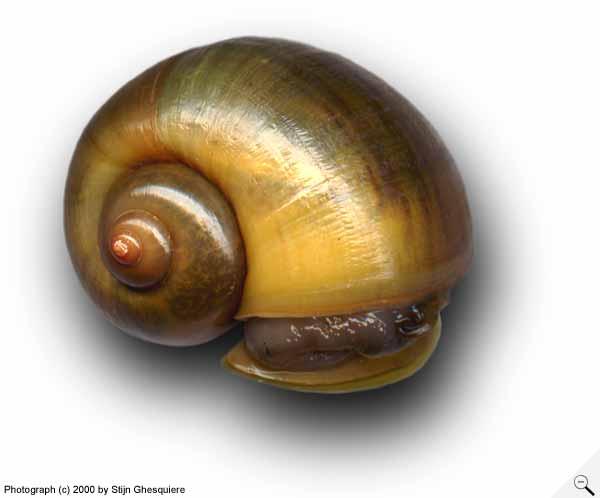Pomacea canaliculata
Channeled Apple Snail
Class: Mollusca
Order: Gastropoda
Family: Ampullariidae

Photographer: Stijin Ghesquiere
Source: applesnail.net
Adult Description: Pomacea canaliculata is a large-sized snail. The globular-shaped shells can have a wide variation of color with banded patterns of black, brown, green, or yellow. Their bodies can be 6cm wide to 8 cm tall with the shell extending up to 15cm.
Egg Description: Bright reddish-pink eggs are laid on rice plants in groupings of 200-600. The eggs are bright red due to their high levels of carotenoid components.
Ecological Threat: The aggressive and successful invasion of the channeled apple snail in irrigated rice systems in many parts of Asia have led to significant economic damages. Direct-seeded rice suffers significantly more damage than trans-planted rice, because golden snails consume greater amounts of the younger, more succulent plants. Snail damage in uncontrolled fields can be as high as 100% for rice seedlings in the germinating stage, as opposed to 20% on average in the transplanting stage. Overall most rice varieties tend to be directly seeded as opposed to transplanted, making them more susceptible to Pomacea canaliculata. Farmers in the infested areas are faced with the options of paying additional costs to control the spread of snails, replanting damaged areas of paddy, or ignoring the problem all together at the risk of potentially large yield losses. Since Pomacea canaliculata has been documented in Texas since at least 1990 it poses a serious ecological and economical threat to the 22 counties that produce rice in Texas. Also, Pomacea canaliculata transmits the Rat lungworm Angiostrongylus cantonensis which can infect humans if they eat raw or undercooked Pomacea canaliculata. The parasite Angiostrongylus cantonensis causes eosinophilic meningitis, which undetected will slowly destroy the human brain and is very fatal.
Biology: The average life span of the snail is 4 years and they reproduce sexually with the male initiating copulation.
History: The snail, indigenous to South America, was introduced into Taiwan from Argentina for commercial production in the 1980s. From Taiwan, the snail was distributed to developing countries to help the rural poor earn additional income through backyard rearing and to supplement protein in their diets. The snail was introduced without prior studies on market demands or its impact on the ecosystem. The snail has spread from South America to Southeast Asia and reached Hawaii in the 1990s. In Hawaii, has caused significant damage to taro even destroying the crop before harvest. Mainly due to the apple snails in 2003, fields of taro for processing reached a record low of 4.8 million pounds, down 17% from the previous year. By 1997 Pomacea canaliculata reached California.
U.S. Habitat: Naturally in slow-moving streams and ponds but has found refuge in rice paddies all over Southeast Asia. This means that lakes, slow-moving streams and rice fields are potentially threatened by this snail.
Resembles: Except for genetic testing, the channeled apple snail is not able to be physically differentiated from its close relative, Pomacea insularium. Due to the physical confusion of the snails “in the field” the distribution of both Pomacea species may have been confused over the years. Pomacea insularium has been established as an invasive in Texas for about 20 years.
Distribution
Native Origin: South America, namely Argentina
U.S. Present: AZ, CA, HI, NC and VA. Records of this snail are not consistent and it may be far more established within the United States.
Management
As it seems to be with most invasives, the channeled apple snail is sold in the trade industry and despite any management the snail cannot be fully controlled until it is not allowed to be sold in the pet trade.
Ducks are a great management tool; but studies have only been performed with Asian breeds of ducks. Unfortunately almost all of the species are not native to North America except the Mallard and the Mallard was the 4th preferred duck to eradicate Pomacea canaliculata. The Mallard only consumed 15 snails per duck as opposed to the top Asian breed, William Siam, which consumed 47 snails per day. However, any consumption of these invasive snails is a benefit; but the Mallard only over winter’s in southeastern Texas, when the snail is significantly less active. So it is not certain is the Mallard and Pomacea canaliculata actually overlapped in southeastern Texas rice counties.
Management of apple snails has generally achieved good results in transplanted rice fields in Japan. Snails do not feed on transplanted rice in shallow water. Keeping paddy water shallow thus helps to control snail damage and is now the most commonly used management practice. Transplanting older rice is also effective because rice gradually becomes tolerant to the snails as it grows. Using these practices, with occasional pesticide applications, snails can be reasonably well controlled in transplanted rice. However, in poorly leveled paddy fields or in regions where very young seedlings are transplanted, the apple snail still remains an important rice pest, which can be very difficult to control.
References
Cowie RH. 2002. Apple snails (Ampullariidae) as agricultural pests: their biology, impacts and management. In: Barker GM, eds. Molluscs as crop pests. Wallingford (UK): CABI Publishing. p 145-192.
Wada, T. 1997. Introduction of the apple snail Pomacea canaliculata and its impact on rice agriculture. In Proceedings of international workshop on biological invasions of ecosystems by pests and beneficial organisms, ed. National Institute of Agro-Environmental Sciences, Tsukuba, Japan, 170-180.
Internet References
http://applesnail.net/content/species/pomacea_canaliculata.htm
Return to Invasive Mollusks and Crustaceans
 Texas Invasive Species Institute
Texas Invasive Species Institute